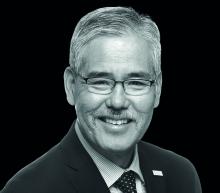
Moderator and former BBC journalist Nick Higham opened ITS International’s two-day MaaS Market 2019 conference in London by saying that he had listened to Mobility as a Service (MaaS) experts over the previous two years at MaaS Market and decided to take action. He lives in London and had given up his car – and says he had saved £700 in a year. “This is a revolution,” he suggested.
In a keynote speech, Paul Campion, CEO of Transport Systems Catapult (since merged with Future Cities to form the Connected Places Catapult), spoke about the importance of meeting traveller expectations. “Our job is to grow the British economy by helping companies to innovate in transport,” he explained. He began by suggesting: “Transport is a matter transmitter. It’s magic, isn’t it? Why did the writers of Star Trek use this as a device? It stops transport getting in the way of the story. They’re just interested in what they do when they get there.”
His point was that most people see transport as a ‘necessary evil’: “We travel to come to work, to a conference, to take the kids to school – it’s a distress purchase. I bought a car, now I have to fill it with petrol. There’s no pleasure in it.”
Transport has three components: infrastructure, vehicles and services. Even if autonomous vehicles (AVs) are going to transform the world by making all the current problems of transport go away, how long will that take? There are 29 million cars in the UK and roughly 5% of them are bought new each year, Campion said. In the UK, 3% of that 5% were electric vehicles (EVs). It is going to take a long time, therefore, for these to become dominant. So AVs or drones are potentially useful modes of travel, “but they’re on the fringe”, he said.
There will be other innovations on the fringe, too. “But if you want the future of mobility, in our career lifetimes it can only come from the way those assets are used – i.e. the services layer,” Campion suggested. “Uber is a perfect example of a services layer.” The ride-hailer used a piece of non-transport technology to disrupt what has been going on for 100 years, spotting that we can pinpoint where people are and where they want to go, and now have the means to connect them with a convenient transport option.
He said that the single biggest intervention which a government can make is regulation that creates markets – and MaaS is a perfect example of that. There is no such thing as a free market; for instance, rail franchises were designed to maximise revenue for the Treasury rather than to make transport more convenient. “Making sure we’re asking the right question is fundamental to getting the right answers,” he went on. “Technological innovation needs to ripple through.”
He illustrated this by mentioning the first power distribution network, set up in 1880 to carry electricity for lighting. But it was not for another 70 years or so that this began to take hold in the economy. Campion related this to the digitalisation of transport. Retail, publishing, music and finance have all been transformed by digital. “Transport, not so much,” he said.
Data will be the key to enabling new services. People want transport convenience, Campion told the MaaS Market delegates. “The opportunity for all of you is to make money by making transport go away.” In other words, travellers really want to spend their time and effort doing interesting things, not just getting from A to B. This should be possible to do “in ways that don’t trash the planet”.
The end user is empowered by mobile technology, he said, but transport is complicated and there is an inherent conflict: “The more freedom I have, the more chance there is for messing things up for everybody else.”
However, the system should be organised so that people’s choices don’t impinge on everybody else – and “we need data to make it happen”.
“I’m saying this is how the future could be – the technology is the same for a utopia or dystopia,” he admitted. “We need to start with an end in mind. Part of our responsibilities is to explain to people how this fits into that better vision.”
Politicians are understandably nervous of being explicit about the trade-offs that more sustainable transport could involve. “Let’s blame ourselves for blaming them for having to make difficult decisions,” he said. “Data is the new infrastructure and we have to take it as seriously. We need to think really carefully about how is this stuff going to get paid for, who’s collecting it? Who’s creating it, who is storing it?”
In a later presentation, Dominick Moxon-Tritsch, director of regulation and public policy at ride-share firm Bolt (previously called Taxify) agreed that the ITS industry must be careful what it does with the data it collects. “In principle we’ve got no problem with data sharing,” he explained.
The company already works with public authorities across Europe, he said, but there is an obligation on firms in the mobility sector to use data responsibly. “There’s a reckoning coming: we don’t intend to be monetising our dataset,” he added. “We’re not in the business of serving up eyeballs for advertisers. We’re a transport business.”
While data is a vital issue, getting the balance of MaaS services right is another - and there will inevitably be useful mobility services which might be left by the wayside. If MaaS is too successful at getting people out of cars, then that would harm car-pool services, for instance. But the conference heard that the practical applications of MaaS are growing. Lauri Suokannas of Taksi Helsinki said the use of taxi services in the Finnish capital was increasing because of user access to MaaS Global’s Whim app. “We are a forerunner, the others are coming after us,” Suokannas said. More than 100,000 trips came through Whim in 2018 –about 5% of the total.
The MaaS Market conference covered a lot of ground, moving from the philosophy of MaaS and how to include members of society who were not digitally-literate, to the nuts and bolts of the services that would be required. Regulation is another challenge for MaaS development, said John Pope, public transport consortium policy advisor for the UK’s Local Government Association. “Regulation has to be in advance of what’s happening,” he said. “We always are behind and then we have to try and regulate it and rein it in.” Thus while there is a need for entrepreneurial flair, there is a balance to be struck. “A lot of legislation is crying out for some reform,” he pointed out. “Taxi legislation is based on legislation from 1847. Children have a right to travel based on the 1944 Education Act. We do seem to be slow to pick up.”
Grand designs
Artur Mausbach from the Royal College of Art’s Intelligent Mobility Design Centre (IMDC) talked at MaaS Market London about the changing perception of the car in a society which is waking up to the problems of congestion and air pollution.
“We have our illusions about cars,” he said. “What’s the role of this vehicle? It used to be the centre of everything. How are we going to replace that?” The visions of future cities are very different from those of modernist architects of the 20th century. “Walking is the best solution for first/last-mile,” said Mausbach. “How much have cars destroyed the city? We ran workshops, public outreach, to create understanding of what people feel about AVs – especially shared shuttles. We like our privacy but maybe these isolated pods are not going to create the best future.”
Rather than a culture of individualism, Mausbach suggested that we need to design into future developments a ‘culture of sharing’. “It’s not about the things, the cars or the infrastructure – we have to understand what people need, to understand their wishes,” he explained. “How far can you use design to create trust? Design used to be about objects – and we extended it to being about the experience those objects create. It depends on where we fix our goals when we are designing.”
On the topic of whether AVs are ‘good, bad or red herrings’, Robbert Lohmann, chief commercial officer of 2getthere, spoke about the difficulties of getting driverless vehicles into mixed transport situations. Everybody wants to aim for vehicles moving autonomously in city centres all over the world – but these are uncontrolled environments, which makes it difficult. “If there’s one thing I’ve learned: people find something stupid and different to do every single day,” Lohmann said. Enabling AVs to deal with that unpredictability is tricky – and low-speed AV trials do not provide added value yet. “You can walk faster than the vehicles are driving,” he pointed out.
According to Michael Hurwitz, head of transport innovation at Transport for London: “It doesn’t matter whether the car has a driver or not – it’s still a less efficient use of road space than a well-stacked double-decker bus.” London has an 80% target for walking, cycling or public transport by 2041.
Clarity of message is important, too. Crissy Ditmore, director of strategy at Cubic Transportation Systems, said there was a need for industry “to get on the same page so we stop confusing the general public” about MaaS. There are currently about 15 different definitions of MaaS but “the industry has to have a common understanding”. Cubic’s definition, for instance, includes the concept of equity for people in transit.
Sandra Witzel, marketing director of Skedgo, insisted that the public and private sectors have to keep talking about this: “We can come up with all sorts of platforms but if the user doesn’t think it’s useful enough, that hard work is wasted.” The pitch to the consumer has to be that the USP “is that you forget your journey and you have a fluent trip experience regardless of the combination of modes you use”.
Hurwitz agreed: “The real risk with the term ‘MaaS’ is it almost becomes the thing in itself. We don’t have a vision for MaaS – we have a vision for the city.”
People want certainty and predictability, concluded John Pope: “MaaS is only a means to an end. We need to see it in the bigger picture: it’s about getting to and from somewhere.”
Fail – fail fast – move on
Dallas is a city and region which has embraced technology. It launched its GoPass Journey app in 2013 – the first multimodal, multi-agency transit fare payment app in the US - and started selling other things on it (such as tickets for the zoo or basketball games) the next year. “We were a little ahead of the curve and people weren’t quite ready to jump on board,” said Gary C Thomas, executive director, Dallas Area Rapid Transit (Dart). But he told MaaS Market delegates that this should not stop you from innovating.
“Try it: if it works, great - if it doesn’t, abandon it, move on. Fail – fail fast. How can we start to do things that the customers really like?”
This is particularly important in an era when change is afoot. “There’s been a lot of transitions in the last five years and they’ve rocked our boat,” Thomas said. “We know Uber and Lyft are both subsidised systems, subsidised by their investors.”
But Uber and Lyft are not going to solve traffic jams. “They might change car ownership,” he said. “There’s still going to be many cities where this isn’t going to solve congestion.” AVs are not the answer, either. “Could be the first time in history that our average occupancy rate could be less than one,” Thomas said. “Think about that.”
In 2019, Dart’s GoPass 3.0 integrated microtransit services, such as Bird, with Uber Pool providing back-up. “We’ll start to wrap in other services,” he said. “The trust issue is between us and our private sector providers. We have to ensure a good trip planner and a good settlement engine – they want to be sure they’re going to be paid in a timely manner.”
That is not to say that micromobility has all gone smoothly. “We should have jettisoned dockless bicycles before we did,” he admitted. While the authorities are keen to create an open culture in Dallas, it was proof that not everything can work unchecked. “It was really that free market approach,” Thomas told delegates. “Within a matter of months there were five companies and 25,000 dockless bikes. They were in front of our trains and littering platforms. In a year they were totally gone. You can’t find them now.”










